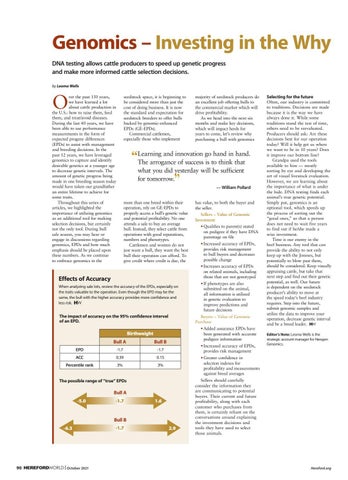Genomics – Investing in the Why DNA testing allows cattle producers to speed up genetic progress and make more informed cattle selection decisions. by Leoma Wells
O
ver the past 150 years, we have learned a lot about cattle production in the U.S.: how to raise them, feed them, and treat/avoid diseases. During the last 40 years, we have been able to use performance measurements in the form of expected progeny differences (EPDs) to assist with management and breeding decisions. In the past 12 years, we have leveraged genomics to capture and identify desirable genetics at a younger age to decrease genetic intervals. The amount of genetic progress being made in one breeding season today would have taken our grandfather an entire lifetime to achieve for some traits. Throughout this series of articles, we highlighted the importance of utilizing genomics as an additional tool for making selection decisions, but certainly not the only tool. During bull sale season, you may hear or engage in discussions regarding genomics, EPDs and how much emphasis should be placed upon these numbers. As we continue to embrace genomics in the
seedstock space, it is beginning to be considered more than just the cost of doing business. It is now the standard and expectation for seedstock breeders to offer bulls backed by genomic-enhanced EPDs (GE-EPDs). Commercial cattlemen, especially those who implement
Learning and innovation go hand in hand. The arrogance of success is to think that what you did yesterday will be sufficient for tomorrow. — William Pollard more than one breed within their operation, rely on GE-EPDs to properly access a bull’s genetic value and potential profitability. No one attends a sale to buy an average bull. Instead, they select cattle from operations with good reputations, numbers and phenotypes. Cattlemen and women do not just want a bull, they want the best bull their operation can afford. To give credit where credit is due, the
has value, to both the buyer and the seller. Sellers – Value of Genomic Investment • Qualifies to parent(s) stated on pedigree if they have DNA parentage on file • Increased accuracy of EPDs, provides risk management to bull buyers and decreases possible change • Increases accuracy of EPDs on related animals, including those that are not genotyped
Effects of Accuracy When analyzing sale lots, review the accuracy of the EPDs, especially on the traits valuable to the operation. Even though the EPD may be the same, the bull with the higher accuracy provides more confidence and less risk.
• If phenotypes are also submitted on the animal, all information is utilized in genetic evaluation to improve predictions and future decisions
The impact of accuracy on the 95% confidence interval of an EPD.
Buyers – Value of Genomic Purchase • Added assurance EPDs have been generated with accurate pedigree information
Birthweight Bull A
Bull B
EPD
-1.7
-1.7
ACC
0.39
0.15
Percentile rank
3%
3%
• Increased accuracy of EPDs, provides risk management
Bull A -5.0
-1.7
1.6
Bull B -6.3
| October 2021
-1.7
Selecting for the future
Often, our industry is committed to traditions. Decisions are made because it is the way we have always done it. While some traditions stand the test of time, others need to be reevaluated. Producers should ask: Are these decisions best for our operation today? Will it help get us where we want to be in 10 years? Does it improve our bottom line? Grandpa used the tools available to him — mostly sorting by eye and developing the art of visual livestock evaluation. However, we are learning about the importance of what is under the hide. DNA testing finds each animal’s true genetic potential. Simply put, genomics is an optional tool, which speeds up the process of sorting out the “good ones,” so that a person does not need to wait five years to find out if he/she made a wise investment. Time is our enemy in the beef business. Any tool that can provide the ability to not only keep up with the Joneses, but potentially to blow past them, should be considered. Keep visually appraising cattle, but take that next step and find out their genetic potential, as well. Our future is dependent on the seedstock producer’s ability to move at the speed today’s beef industry requires. Step into the future, submit genomic samples and utilize the data to improve your operation, decrease genetic interval and be a breed leader. Editor’s Note: Leoma Wells is the strategic account manager for Neogen Genomics.
• Greater confidence in selection indexes for profitability and measurements against breed averages
The possible range of “true” EPDs
90
majority of seedstock producers do an excellent job offering bulls to the commercial market which will drive profitability. As we head into the next six months and make key decisions, which will impact herds for years to come, let’s review why purchasing a bull with genomics
2.9
Sellers should carefully consider the information they are communicating to potential buyers. Their current and future profitability, along with each customer who purchases from them, is certainly reliant on the conversations around explaining the investment decisions and tools they have used to select those animals.
Hereford.org
